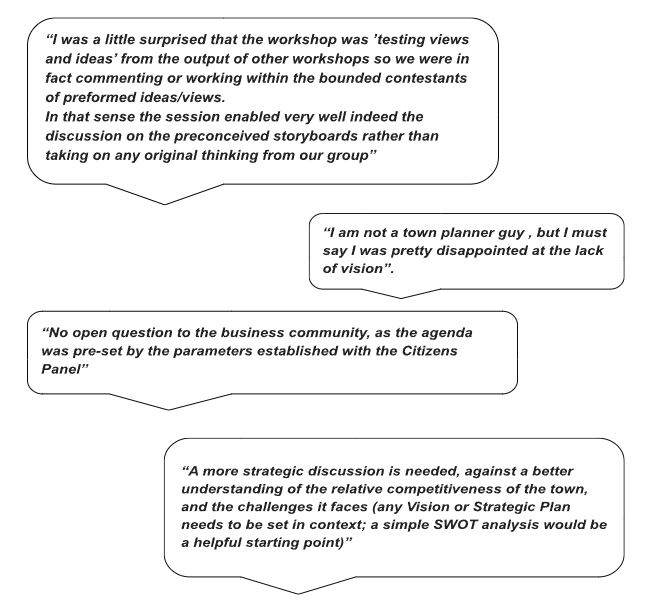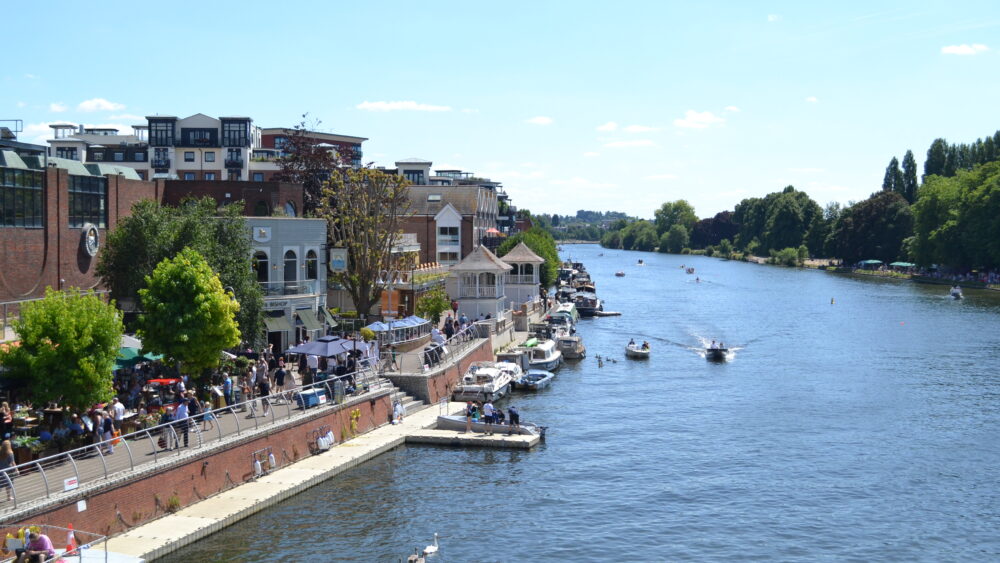Today we have published our response to the councils draft Town Centre Vision, you can read the response in full below.
Background
We know a vision for Kingston town centre is fundamental for setting the direction of a place and creating a town where people want to live, work, study and visit. Over 90% of our members from different industries and sectors agreed with us; that’s why we included the development of a vision in our Business Plan and urged Kingston Council to help make this happen.
For Kingston First and the 700 businesses and organisations we represent in the area, creating a vision is more than a document; it’s an opportunity to get people excited and involve them on a journey to create a unique place, and to bring a different way of thinking and approach to making things happen. While we have been working with the council to shape the development of the Vision, the direction and approach of the current draft does not align with our views of what makes a great vision. Our own insights and feedback from members have highlighted that the current draft could be more ambitious, engaging and tackle difficult issues such as transport, to really unlock the true potential of Kingston town centre’s future.
Feedback on current draft Vision document
Kingston First has drawn on its own knowledge and insights and led its own workshops and engagement sessions with member businesses, landlords and developers to guide our response and recommendations to the draft Vision document published by the council. Underpinning our response to the draft are key principles which we believe are crucial to creating and delivering a Town Centre Vision.
Our response to the consultation is structured as follows:
- What makes a great Vision
- The process of creating a Vision
- Presentation and Language of draft Vision doc
- Recommendations for themes/focus for the town Vision
- Conclusion
- Annex A: – Feedback from Kingston First and stakeholders on the Big Ideas in the draft Vision document.
1. What makes a great Vision
To be successful at creating and delivering a Town Centre Vision, Kingston First believes a great vision needs to do the following:
- Be forward looking and inspirational
- Create a sense of excitement amongst different audiences
- Involve people in its development (residents, visitors, businesses, landlords, developers, University, College, charities and community organisations, public services, young people and students etc)
- Relate to its local communities and recognise its assets
- Build confidence by being realistic about what can be achieved
- Be clear about what it will do and what the impact will be for different members of the community, bringing it to life with examples of projects
- Use language that is clear and understandable to different audiences
- Identify champions to promote the vision to all corners of the communities
- Demonstrate accountability for what has been set out/promised
2. Process of developing a town centre Vision
Kingston First has lobbied and championed the need for a town centre Vision with stakeholders, members, Council officers, Councillors and the Leader throughout its term. We entered a partnership approach with the council to develop the Vision but early on raised concerns about the approach, ways of working and pace of development. We felt too much focus was on a document rather than cultivating a systematic change in thinking that would allow for something truly visionary. We have always believed the development of a Vision for the town centre should embrace and foster the principles we’ve mentioned in ‘What makes a great Vision’, specifically bringing and involving people from all parts of the community on the journey. Unfortunately feedback from many businesses, developers and landowners who attended council led workshops and engagement sessions didn’t feel they were taken on a journey and were really listened to, but rather that it felt the Vision had already been decided. A selection of these comments are below:

3. Presentation and language
The current draft Vision contains ‘Six Big ideas’, ‘Four ambitions’ and ‘33 objectives’. There is significant cross-over within these which makes it difficult for the reader to understand what the key focus/ambition is. It reads as a tactical document with the objectives owned by the council, positioning itself as being responsible for delivering them. This in turn means it will be more difficult to get buy-in and support from all corners of Kingston’s communities. There is an opportunity to be clearer about the priorities and be more relatable to different audiences, helping the reader understand what will be different and what the impact will be.
Some of the ‘ideas’ and objectives contain long-winded statements that are contradictory and leave the reader wondering what the meaning is. Some of the objectives read as being ‘business as usual’ rather than setting direction. We’ve provided some examples in the Annex but would encourage the use of clear accessible language throughout and a streamlining of objectives/priorities to help people connect and feel engaged with the Vision.
4. Recommendations for themes of focus
We hear from our members, across sectors and sizes, on a daily basis about their views, thoughts and ideas for Kingston and have a wealth of knowledge based on this. Last month, we also hosted our own workshops and asked members, landowners and developers what the town centre should look and feel like in 10 years time, what they like and dislike now and what they would gift Kingston for the future.

We have consolidated this feedback and insights into the following themes:
- Riverside
- Transport and Movement
- A town fit for the future generations
In conversations about the future of Kingston, members and stakeholders referred to better connectivity across the town (wayfinding), digital inclusion, connection and partnerships between diverse communities and businesses, improving connections to and from Kingston and making the town more pedestrian and cycle friendly with better connected services. We think a vision which centres on the idea of connect (also relates to connection and connectivity) is relevant and needed for the three themes we have identified. It could also be an overarching theme and knit the different focus/priorities together.
Key Theme 1 – Riverside
- A focus on river improvements and investments cultivating more leisure and entertainment opportunities which will also help position the town as a distinct destination that comes alive day and night. A pontoon on a river, Kingston beach, Thames swimming, pop-up markets for example.
- There is an appetite for more blue crossings, for example a bridge for people/cycles across to Hampton to make the experience of travelling to and from Kingston more inviting. People can rent bikes in Kingston and avoid congested streets to explore Home Park/Surrey.
- The public realm along the riverside to be better connected and more inviting to encourage residents and visitors to spend time on the river. This includes the introduction of lighting and creating safer environments. This will have an impact on people’s health and well-being.
- We need a vision and shared aspirations on how to further strengthen the river as an asset and evolve our riverside offer, quality of experience and connections.
Key Theme 2 – Movement and transport
- In order for Kingston to become a town in which commuters, visitors, tourists and residents can ‘stay all day’ and enable growth sustainably, improved train transportation into Kingston needs to be pursued ambitiously, with joint lobbying of TFL and other transport providers to improve both fast and slow train options to the town. As an objective within the vision this idea should be communicated more clearly.
- An improvement in transport to and through the town would reap many further benefits- from enabling talented employees to relocate, to enticing more day visitors and tourism, to encouraging more active travel and public transport journeys.
- Feedback and insights identified the outcome of improved wellbeing within the town if transport is delivered well, which will underpin economic growth and healthy communities.
- Ease of traffic- more pedestrian walkways, better accessibility for cyclists and continuation of cycle lanes. Develop the infrastructure for active travel.
- For tourism: better connections to London and further afield. Weekenders infrastructure. Hotels. Kingston needs something more of an attraction for weekenders.
- A reoccurring suggestion was for a cycle and pedestrian only bridge across the Thames towards Hampton Court, linking with improved cycle ways and cycle infrastructure, such as storage at appropriate locations (to be identified through consultation with users).
- There is strong view (and our own) that we need further work to align people on issues and opportunities around transport.
Key Theme 3 – A town fit for future generations
- There is an opportunity with the development of the Vision to give focus to how the community of Kingston evolves over time and to provide the infrastructure to support this. Future proof the town by creating a path from education to life and work in Kingston It does not feel like a University town for example. Supporting young people could enable students to stay and grow into the town.
- Another major focus could be on senior living in the town centre with the ecosystem that supported-living brings being regarded as an asset.
- Prioritise affordable housing in the town centre. Supporting graduates to become the new Kingston community
- Facilitating and supporting a diverse mix of use within the town (new workspace, co-living spaces, support for start-up/entrepreneurs as well as a place people want to be in day and night) will help us be attractive for future generations and businesses and investments (building on Unilever success) help retain businesses and young people.
- Local businesses are incubated and supported in Kingston, with options to support new start ups, leading into growth opportunities. It is important to provide secure tenures and accessible/affordable spaces. In order to attract talent, businesses and employees to the town, the other areas of the vision such as transport, housing and community need to be shored up.
- Emphasis should be placed on embracing of new communities (e.g. Hong Kong and Korean residents) and the strength of a diverse community (including diversity of age, income and background) and putting in place the infrastructure (15 minute city concept, internet connectivity) to help encourage and facilitate people living in the town centre.
- Improved infrastructure such as transport, accommodation and attractions should be incorporated to encourage more tourism and weekend trips. Kingston could benefit from its position next to other attractions such as Richmond Park and Hampton Court to create a connected pocket of attractions. Thinking ambitiously here could greatly benefit the town.
- Different cultural milestones and events should be celebrated within the town to help embed this diverse and evolving community spirit.
Key obstacle to bringing a Vision to life
We heard and wanted to share feedback from landowners and developers who have highlighted a frustration due to the disconnect between planning and policy within Kingston Council and poor communication between departments and with landowners/developers. There is a sense that landowners/developers face unnecessary obstacles and that the council lacks agility. If the systems in place can be improved then many other benefits for Kingston will be forthcoming.
5. Conclusion
Through our engagement with members and key stakeholders and drawing on our own insights, Kingston First recommends that the next iteration of the Vision focuses on the following themes Riverside, Movement and Transport and A Town Fit for Future Generations. There is an opportunity now for the council to take into consideration our feedback and insights and to drill down and focus on the priorities for the town over the next 10 years. The confusing, repetitive and sometimes conflicting content of the draft vision means different communities will struggle to engage with this and help make it happen. We risk the vision becoming a document that sits on a shelf rather than creating excitement for an ambitious town centre, delivered in partnership with stakeholders being able to bring resources, investment, ideas, expertise and wider community ‘buy-in’ to how the town changes and evolves.
Referring back to the key principles of what makes a good Vision, we recommend further consideration, should be given to the dominant theme that recurred throughout our conversations and insights gathering, ‘Connect’ with members and stakeholders. This has the potential to help engage audiences and take them on a journey and be the foundation to create a distinct Vision for Kingston.
Annex A: Big Ideas feedback
Big Idea 1: Riversides. Connect our riverfronts and make them more lively, active and easy to access and explore
- The river is seen as a huge opportunity for the town by occupier businesses, landowners and developers.
- Specific suggestions include; a cycle/pedestrian bridge towards Hampton Court, attractions and experiences along river for visitors as well as local workers and residents, walkway by the river should be widened to allow more activity.
- Wayfinding to and from the riverside needs to be improved as well as a more connected riverside. At the moment the path from ‘The Riverside’ to ‘Canbury Gardens’ is disjointed.
- Be ambitious e.g. Kingston beach, Thames swimming, cycle/pedestrian bridge, pontoon/platform on river.
- We recommend consideration is given to the content of the statement, as “Lively and active”, and “easy to access and explore” refer to different things and this has caused confusion with stakeholders we have spoken to. There is an opportunity to be much clearer and specific about what will be the focus and what will be different.
Big Idea 2: Transport. Improve our major transport corridors and the ring road to be better for pedestrians and cyclists, greener, and healthier. Reduce vehicle movements in the town centre.
- Transport is a critical issue for the majority of our stakeholders and deserves focus and priority.
- It puts cars first not cyclists or pedestrians and the terminology is confusing e.g. what is a transport corridor?
- In the statement the ring road is made central to the idea rather than active transport or public transport options.
- Improved rail links are imperative (fast and slow train options) to bring more people to the town. Focus should be on influencing TfL to make this happen.
- Current cycle parking at the station is poorly used and not in the right location- in the future consultation with users should be carried out to identify the most suitable locations.
Big Idea 3: Use and character. Cluster, consolidate and integrate different uses and activities to create vibrant and distinctive quarters. (This idea was not scanned by local businesses and organisations)
- Developers and landowners felt that Kingston is not big enough for quarters to work effectively. There are not enough options for each quarter (e.g. cultural options) in a town the size of Kingston.
- The discovery of different shops/restaurants in Kingston’s nooks and crannies is central to the town’s character.
- This approach risks the creation of ‘dead areas’ if activity is densified and centralised to certain areas of the town. Areas would become stagnant if land doesn’t come forward for development.
- Instead, consider the organic growth and creation of areas and how different parcels are joined up.
Big Idea 4: Sustainability. Make Kingston a greener and more accessible town centre with increased biodiversity and natural habitats, low carbon infrastructures and improved flood and extreme temperature resilience
- If we’re referencing sustainability as a big idea – we need a big idea that sets us apart from other towns. The statement doesn’t feel very visionary and seems like business as usual and could be any town in the UK. What is going to be different in 10 years time? The ideas suggested are already in place/about to happen.
- Too many separate statements (separate ideas underlined) “Make Kingston a greener and (more accessible) town centre” with increased biodiversity and natural habitats, low carbon infrastructures and improved flood and extreme temperature resilience‘. Leads to a confusing idea which you struggle to relate to and decipher the meaning.
- Will there be a benchmark/targets for increased biodiversity, improved air quality, improved water quality etc?
- Add education into the idea- what greening is, how the way we live impacts upon it.
Big Idea 5: Culture and Heritage. Celebrate, connect, enhance and promote our cherished built and cultural heritage, landmarks and special places
- We are supportive of the idea of making Kingston a heritage destination, celebrating the historic character of the town but the idea seems unclear as a principle. ‘Celebrate, Enhance and promote’ have similar meanings so suggest the language is made simpler to help strengthen the meaning. We are not sure what special places are- this is likely to be unique to individuals.
- Several suggestions focused on the King’s Stone. Move it to a more prominent position (green by the church).
- There is an opportunity to celebrate the old but also embrace the culture of existing and new communities in Kingston.
Big Idea 6: Public Realm. Enhance the look and feel of the streets and places we use everyday
- There is an opportunity to use local landmarks as an important part of wayfinding in the town.
- Safety, security, and lighting needs to be prioritised in public realm developments
- Planters and benches need to be maintained otherwise can deduct from the look and feel of a place- whose responsibility will this be?
- Ensure this doesn’t hinder the way that people move through the public realm




Comments are closed.